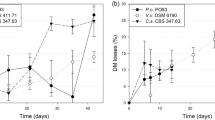Summary
In laboratory and semi-industrial scale experiments the influence of the substrate water content, temperature, and incubation time on the progress of solid state fermentation of straw colonized by white rot fungi was investigated. The parameters used to evaluate the fermentation process were degradation of total organic matter and lignin, in vitro digestibility, the content of water soluble substances in the substrate and the pH.
The degradation of total organic matter was species specific. Only Trametes hirsuta enhanced the degradation at elevated temperature (30 °C). With Abortiporus biennis, Ganoderma applanatum, and Pleurotus serotinus, elevated temperature had and adverse effect. Prolonged incubation only improved degradation of straw by the relatively slowgrowing fungi Ganoderma applanatum, Lenzites betulina, and Pleurotus sajor caju.
Elevated temperature and prolonged incubation shifted the relative degradation rates in favour of total organic matter degradation. With Ganoderma applanatum, Pleurotus ostreatus, and Pleurotus serotinus lignin degradation, even on an absolute scale, was less at 30 °C than at 22 °C.
In general, the in vitro digestibility also decreased, when the incubation time and temperature were raised. With Ganoderma applanatum the in vitro digestibility dropped below the value of the sterile straw control.
Solid state fermentation of straw was at an optimum at a medium water content of 75 ml/25 g of substrate. However, most of the fungi tested could digest straw over a wide range of water content. At higher water contents (125–150 ml/25 g of substrate) an increased production of aerial mycelium was observed.
In semi-industrial batch experiments (40 kg) with Abortiporus biennis the in vitro digestibility dropped below the reference value for sterile straw during the first 19 days of incubation. Later, the in vitro digestibility again rose and reached its optimum after about 60 days. The in vitro digestibility in the semi-industrial experiments was always lower than in the laboratory experiments (+9% and +25%, respectively).
In long term experiments (2.5 kg batches, 8 months of incubation) very different values for the in vitro digestibility were found, and these depended on the fungus used (Abortiporus biennis, +16%; Pleurotus ostreatus, +4%; and Ganoderma applanatum, −27%).
Similar content being viewed by others
References
Ammer U (1963) Forstwiss Centralbl 82:360–391
Barrows I, Seal KJ, Eggins HDW (1979) Biodegradation of barley straw by Coprinus cinereus for the production of ruminent feed in: Grossbard E (3d) Straw decay and its effect on utilization and disposal. John Wiley & Sons LTD, Chichester, New York, Brisbane, Toronto, pp 147–154
Bavendamm W, Reichelt H (1939) Arch Mikrobiol 10:486–544
Beck K (1977) Der Champignon 193:17–27
Francescuti B (1972) Verfahren und Vorrichtungen zum Anbau von Pilzen. Deutsches Patentamt (Offenlegungsschrift) 2251 90
Gerrits JPG (1975) Champignoncultuur 19:254–260
Griffin DM (1977) Ann Rev Phytopathol 15:319–329
Halse OM (1926) Papier Journalen 10:121–126
Hartley RD, Jones EC, King NJ, Smith GA (1974) J Sci Food Agric 25:433–437
Henke D (1979) Mushroom Sci X:137–147
Kirk KT, Moore WE (1972) Wood Fiber 4:72–79
Lehmann KB, Scheibe E (1923) Arch Hyg 92:89–108
Letham MJ (1979) Pretreatment of barley straw with white rot fungi to improve digestion. In: Grossbard E (ed) Straw decay and its effect on utilization and disposal. John Wiley & Sons LTD, Chichester, New York, Brisbane, Toronto, p 131–137
Lindenfelser LA, Detroy RW, Ramstack IM, Worden KA (1979) Dev Ind Microbiol 20:541–551
Rypáček V (1952) Spysy vyd Přírodovědeckou fakultou, Masarykovy University v Brně 335:49–7
Rypáček V (1966) Biologie holzzerstörender Pilze, VEB G Fisher Verlag, Jena
Scháněl L, Rypáček V (1958) Spysy vyd Přírodovědeckou fakultou Masarykova University v Brně 336–396
Tilley JMA, Terry RA (1963) J Br Grassl Soc 18:104–111
Zadražil F (1976) Z Acker Pflanzenbau 142:44–52
Zadražil F (1977) Eur J Appl Microbiol Biotechnol 4:273–281
Zadražil F (1979) Mushroom Sci X:231–241
Zadražil F, Brunnert H (1979) Z Pflanzenernaehr Bodenkd 142:446–455
Zadražil F, Brunnert H (1980) Eur J Appl Microbiol Biotechnol 9:37–44
Author information
Authors and Affiliations
Rights and permissions
About this article
Cite this article
Zadražil, F., Brunnert, H. Investigation of physical parameters important for the solid state fermentation of straw by white rot fungi. European J. Appl. Microbiol. Biotechnol. 11, 183–188 (1981). https://doi.org/10.1007/BF00511259
Received:
Issue Date:
DOI: https://doi.org/10.1007/BF00511259




